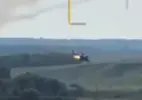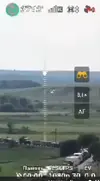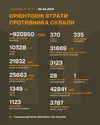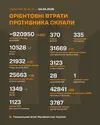viimeinen mohikaani
Kenraali
Kuvakaappaus tänään julkaistulta ryssän ISR-dronen torjuntavideolta, näyttää kiinteäsiipiseltä eikä monikopterilta (torjuja on pienempi valkea "lennokki", torjunnan kohde suurempi musta drone):
That's not a quad-copter FPV.
Looking good for the faster interceptors.
Katso liite: 121001
Tällä kertaa kohteena näyttäisi olevan ryssän Supercam S350 -tiedusteludrooni. Alla Googlen konekäännös puolankielisestä wikipediasivusta.
The drone was designed by the Izhmash plant ( Russian: ООО «Ижмаш – Беспилотные системы» ) based on the earlier Supercam S300 model. It is designed for terrain monitoring and aerial photography. The equipment allows for video signal transmission at a distance of 100 km. Inside, it can carry equipment consisting of gyroscopically stabilized visible band cameras with a resolution of 20/24/42/60 megapixels with 10/33× optical zoom and infrared, as well as measuring equipment. The drone can carry three containers with utility equipment, two of which can contain cameras.
The machine is made of composite materials. The engine is powered by two replaceable batteries placed in the middle of the wing. Take-off is performed using a catapult with a flexible or pneumatic drive. Landing is performed using a parachute. During touchdown, the outer sections of the wings may be released to prevent their possible damage. In 2022, the drone became part of the equipment of the army units of the Russian Federation and was used during the aggression against Ukraine. According to official reports, it has shown high resistance to the operation of electronic warfare systems.
On May 18, 2024, TASS reported that a development version designated as Supercam S350M had been created. The changes introduced included reducing the airframe's weight, which extended the flight time by 20%. The modified drone has an automatic data processing function and the ability to transmit a video signal to other systems in real time. In addition, the S350M can act as a radio signal amplifier, which allows the use of other FPV drones at greater distances than before.
The operator works in a ground container that can be installed on any chassis. The system can consist of two drones. The flight is carried out in autonomous or semi-autonomous mode, the operator can change the route, altitude and other parameters during the flight. After landing, the drone's position is signaled by a radio transmitter with a range of 3 km.
Tärkeitä pudotuksia nämäkin: Iskandereita ja muuta paskaa tulee vähemmän niskaan, kun ylimääräiset suristimet ammutaan alas taivaalta. Tiedustelutehtävien ohella Supercam S350 toimii myös tukiasemana FPV-drooneille. Lentoonlähtö tehdään katapultista ja laskeutuminen tapahtuu laskuvarjon varassa. Pöpelikköön laskeutumisen jälkeen tiedusteludroonia voidaan etsiskellä jollakin perinteistä koiratutkaa muistuttavalla radiosuuntimalaitteella?













 Tilannekatsaus 3. erillisen rynnäkköprikaatin 1. rynnäkköpataljoonan vastuualueella
Tilannekatsaus 3. erillisen rynnäkköprikaatin 1. rynnäkköpataljoonan vastuualueella ️Tilanne 1. rynnäkköpataljoonan vastuualueella on edelleen jännittynyt. Vihollinen käytti hyväkseen huonoja sääolosuhteita ja onnistui keskittämään joukkojaan etulinjan asemille. Aamunkoitteessa se aloitti hyökkäystoimet neljällä eri suunnalla yhtä aikaa, käyttäen noin 50 jalkaväensotilasta.
️Tilanne 1. rynnäkköpataljoonan vastuualueella on edelleen jännittynyt. Vihollinen käytti hyväkseen huonoja sääolosuhteita ja onnistui keskittämään joukkojaan etulinjan asemille. Aamunkoitteessa se aloitti hyökkäystoimet neljällä eri suunnalla yhtä aikaa, käyttäen noin 50 jalkaväensotilasta. Tämänhetkisten tietojen mukaan 80 % vihollisen joukoista on tuhottu. Loput jatkavat taistelua lähietäisyydeltä yrittäen vallata asemamme.
Tämänhetkisten tietojen mukaan 80 % vihollisen joukoista on tuhottu. Loput jatkavat taistelua lähietäisyydeltä yrittäen vallata asemamme. Erityisesti ovat kunnostautuneet 1. ja 3. rynnäkkökomppanian sotilaat, jotka lähitaistelussa aiheuttivat viholliselle merkittäviä tappioita, pitivät puolustusasemansa ja jatkavat taistelua.
Erityisesti ovat kunnostautuneet 1. ja 3. rynnäkkökomppanian sotilaat, jotka lähitaistelussa aiheuttivat viholliselle merkittäviä tappioita, pitivät puolustusasemansa ja jatkavat taistelua. Sään parantuessa hyökkäyksen torjuntaan liittyivät iskudronien ja pudotuksia suorittavien droonien miehistöt. Niiden tehokas toiminta ei anna viholliselle mahdollisuutta selviytyä – edes perääntymisyritysten aikana.
Sään parantuessa hyökkäyksen torjuntaan liittyivät iskudronien ja pudotuksia suorittavien droonien miehistöt. Niiden tehokas toiminta ei anna viholliselle mahdollisuutta selviytyä – edes perääntymisyritysten aikana.

